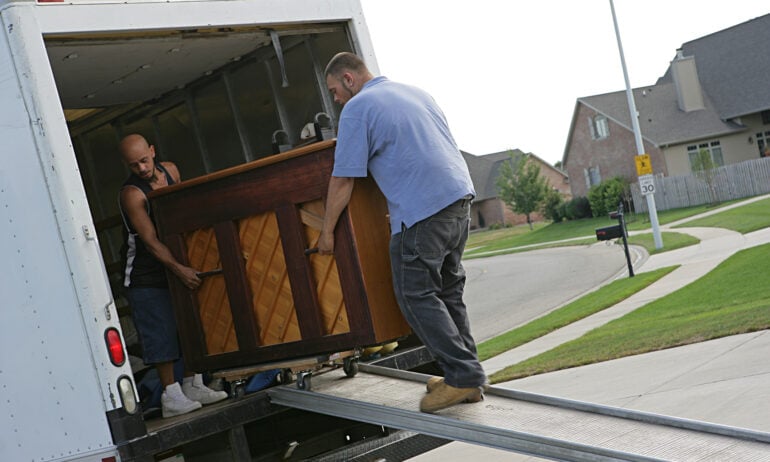Piano Moving: How to Do It, What It Costs
Moving a piano is tricky and can damage the instrument or flooring if you're not careful. Here's what to do and avoid.

Some or all of the mortgage lenders featured on our site are advertising partners of NerdWallet, but this does not influence our evaluations, lender star ratings or the order in which lenders are listed on the page. Our opinions are our own. Here is a list of our partners.
Moving a piano is hard work that can damage the instrument or underlying flooring if not done properly. This job is best done by professional full-service or dedicated piano movers, but with proper tools, physical strength and skills, it can be a job for very experienced DIYers.
on moveBuddha's website
on moveBuddha's website
on moveBuddha's website
How much does it cost to move a piano?
Moving a piano professionally typically costs between $250 and $600. It can be significantly more for long-distance moves, particularly for certain models, such as grand pianos. A number of factors affect what your actual price will be.
Type of piano. Grand pianos take up more space and require more preparation and labor to move than upright models.
Size and weight. Generally, the larger and heavier the piano, the higher the cost to move it.
Distance. The farther you have to move your piano, the more you’ll probably pay to have it moved.
National versus international moving. Moving a piano out of the continental United States generally costs more.
Stairs and other obstacles. If your movers have to carry your piano up or down stairs or navigate narrow passageways/obstacles, moving charges will likely increase.
Required tools and materials. The more tools and equipment required for your piano move, the higher your costs.
Location. Area gas prices and navigability of streets affect your costs.
Dismantling and crating requirements. Grand pianos need to be partially dismantled to move, which adds to labor costs. If your piano needs to be wrapped and crated for the move, this can also increase your expense.
Related items. Additional items that have to be moved with the piano (such as benches) may add to costs.
Storage. If you need to have your piano stored in a climate-controlled space during your move, your total cost will be higher than a straight move from point A to point B.
Flooring. If your piano has to be moved over easily damaged flooring such as hardwood, stone, ceramic or vinyl, the movers will have to put down pads and runners, and they may even need protective booties. This extra labor can increase your bill.
Emergency moves. Expedited shipping charges may significantly raise your moving costs.
» MORE: How much does it cost to move?
How to move a piano
Transporting a piano generally involves 12 basic steps.
Gather the necessary tools and supplies:
Tape measure.
Disassembly tools, including screwdrivers and wrenches.
Moving blankets, stretch wrap and pads.
Piano dolly.
Work gloves.
Protective floor coverings.
Lifting straps.
Packing tape.
Ratchet straps for securing piano to the van.
Ramp for loading and unloading.
Take measurements. Measure the piano and all doorways, stairways, hallways and narrow spaces involved.
Protect flooring. Lay down protective cardboard or material and tape it down to prevent damage.
Perform any necessary disassembly. Remove legs and any other removable piano parts including the lid prop, piano lid and music rack.
Wrap/pad the piano. Wrap the piano and all components in moving blankets and stretch wrap, and securely pack screws for transport.
Transfer piano onto a dolly. Using lifting straps, and working with at least one other person, lift the piano and carefully place it on the dolly.
Load piano onto the transport vehicle. With a ramp in place, wheel the piano into the transport vehicle and secure it with ratchet straps so it won’t shift or slip during the trip.
Transport the piano. Drive the piano to its destination, preferably in a climate-controlled vehicle.
Prepare the unloading area. Measure tight spaces carefully and lay protective material over any fragile flooring.
Unload the piano. Assemble the ramp, remove ratchet straps and roll the piano into the new location on a dolly.
Assemble/set up the piano. Reattach the legs and any other components that were removed for transport.
Tune the piano. Arrange to have this done as soon as possible after the move. Even the most careful move will probably affect your piano’s delicate tuning. You’ll need to have a professional tuner make sure the piano is in proper condition and sounding its best.
What not to do when moving a piano
Professional movers and DIYers should be careful to avoid common mistakes, which include:
Going it alone. Depending on size and model, pianos can weigh anywhere from 200 pounds for a spinet to as much as 1,200 pounds for a concert grand piano. Trying to lift a piano alone can cause injury and damage the instrument.
Using improper lifting techniques. Even with a helper or two, not lifting properly can cause injury.
Not bothering with preparation. Not protecting the piano or flooring can result in damage to both.
Forcing the piano through narrow spaces. This will likely damage the piano, the walls and the floor.
Not properly prepping/wrapping the piano. An unprotected piano can easily be damaged during transport.
Not securing the piano properly in the truck. If the piano shifts or rolls around in the truck during transport, it will likely get damaged and cause damage to nearby items.
Not controlling the climate. Pianos are delicate instruments that are easily damaged by extreme temperatures and humidity levels.
Who can move a piano?
A number of national, full-service movers offer piano moving, including:
If your piano is especially rare or valuable, consider hiring a dedicated professional piano moving company.
Can you move a piano yourself?
With proper tools and skills, it’s possible to move your own piano by renting a van and enlisting the help of friends. DIY piano moving isn’t generally recommended, however. Here’s why:
Weight. Pianos can weigh more than 1,000 pounds.
Shape. Pianos have an awkward shape and an unusual center of gravity that makes them difficult to move.
Fragility. Even the slightest bump or abrupt change in temperature/humidity can damage the instrument.
Injury risk. You could easily injure yourself or others moving something so heavy.
Property damage and liability risk. Improper handling of a piano could damage floors, stairways and walls.
Piano moving is a difficult job, and not one for beginners. In fact, just changing a piano’s location within a concert venue requires extreme care and attention. Because of this, it may be wiser to arrange for professional movers and take this complex DIY task off your moving checklist.








